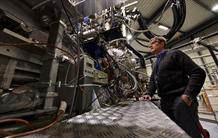The CERN Axion Solar Telescope (CAST experiment) has ruled out the existence of axions in an energy range that had been unreachable in previous experiments. Axions are light hypothetical particles that would only interact very weakly with ordinary matter, and could constitute dark matter. The unique performances of the Micromegas detector developed at IRFU have contributed to this result.
Axions were postulated in the 1970s, initially to solve the significant question in particle physics of the asymmetry between matter and antimatter, which were initially produced in equal amounts. These hypothetical particles have not yet been detected.
The principle of the CAST experiment is to convert axions coming from the Sun into X-rays using an intense magnetic field (9 teslas) produced by a magnet similar to those in the LHC. Observing one of these rare events would be a real feat: one solar axion is expected to be produced every thirty hours.
The sensitivity of CAST was improved by a factor of three, in particular thanks to a Micromegas-type gas detector, adapted to the focal plane of X-ray optics, developed at the Lawrence Livermore Laboratory, USA. For the first time, the sensitivity achieved by CAST was similar to that of astrophysical observations.
The Micromegas-X-ray optics combination will be used in the International Axion Observatory (IAXO), a future experiment aimed at improving the sensitivity by a factor of 15 compared to the best current limits.
Contacts: Stephan Aune, Esther Ferrer-Ribas, Ioannis Giomataris, Thomas Papaevangelou


